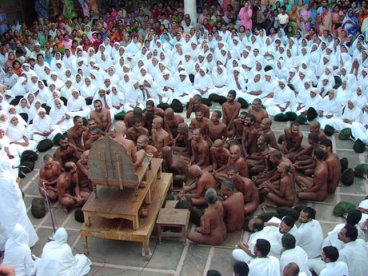The founder of the Jain community was Vardhamana, the last Jina in a series of 24 who lived in East India. He attained enlightenment after 13 years of deprivation and committed the act of salekhana, fasting to death, in 420 BCE. Jainism has many similarities to Hinduism and Buddhism which developed in the same part of the world. They believe in karma and reincarnation as do Hindus but they believe that enlightenment and liberation from this cycle can only be achieved through asceticism. Jains follow fruititarianism. This is the practice of only eating that which will not kill the plant or animal from which it is taken. They also practice ahimsa, non-violence, because any act of violence against a living thing creates negative karma which will adversely affect one's next life.
There are two main divisions or groups in Jainism - the Digambara and the Svetambara. Here's the background story that explains their origins.

According to tradition, some of the Jain community moved at the direction of their political leaders to the south to avoid a predicted famine. Others stayed behind in the north. After about a dozen years or so, those who migrated south came back and found that their brethren who had stayed in the north had become lax in their practice of austerity, even wearing white robes. This was inadmissible, in their view, for Jain monk since to renounce meant to renounce all attachments and bindings, including the emotion of shame at ones nakedness from having no possessions - not even clothes.
So, a schism occurred and they split into 2 sects:The 2 sects have drifted away from each other and are active in different parts of India. The “sky clad” have reduced numbers of monks, due to the rigor of the order, and are made up mainly of householders.
The white-clad are quite sizeable in their monastic communities. A “Reformation” of sorts occurred in their group in the 1653 CE when a reform movement called Sthanakavasis (“dwellers in the halls”) condemned what had become the practice of worshipping at the Jain shrines by decorating the statues of “jinas” (i.e. Mahavira) with silk and jewels. The reform movement condemned all forms of iconolatry and temple worship as inconsistent with the teachings of Mahavira
This schism between the “white clad” and the “sky clad” has no real impact on what are believed to be the central teachings of Mahavira. The basic teachings remain consistent across the 2 groups.
source: www.world-religions-professor.com/digambara.html
No comments:
Post a Comment